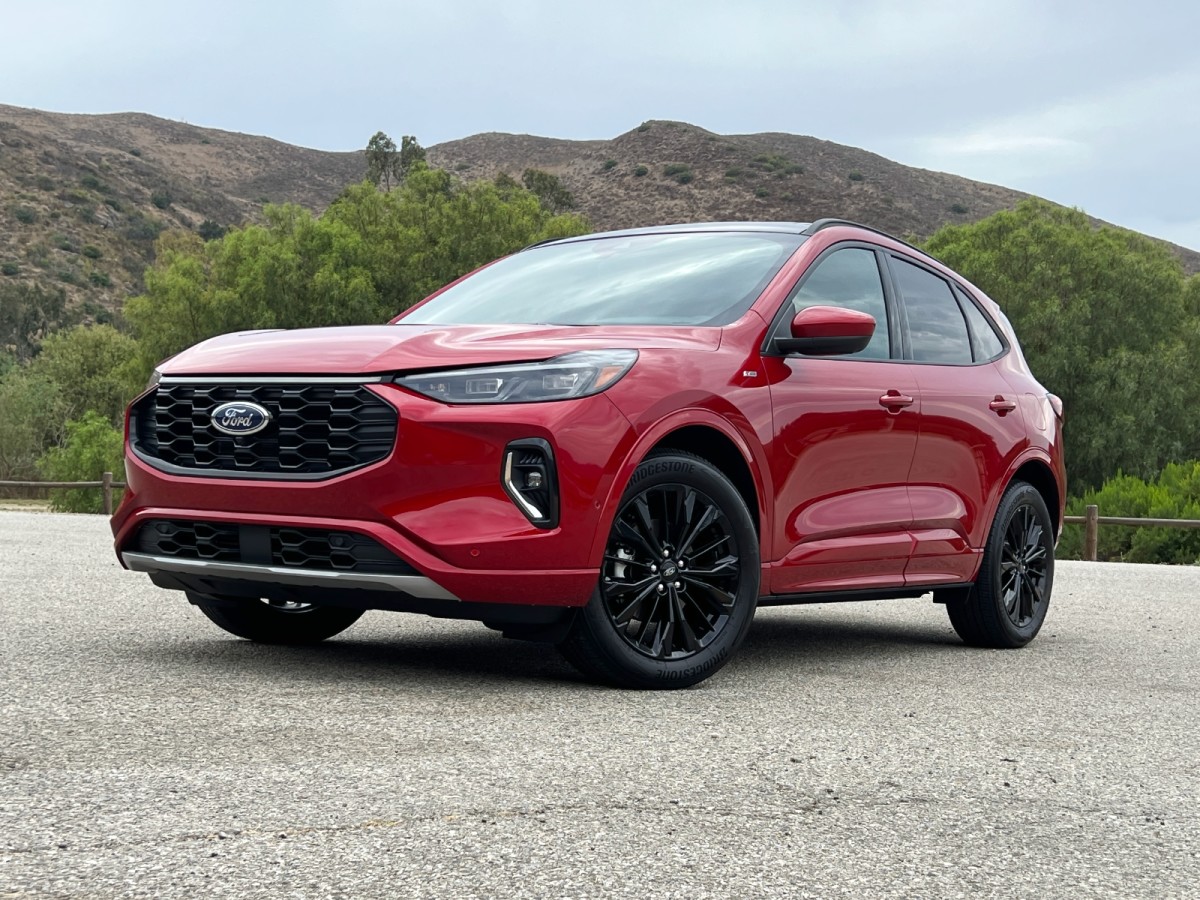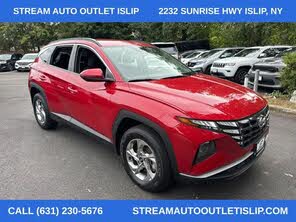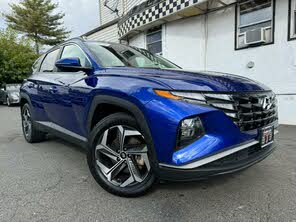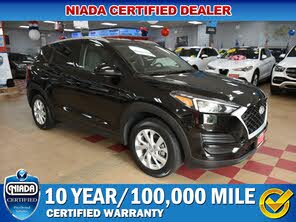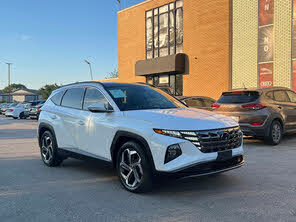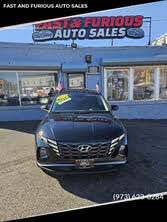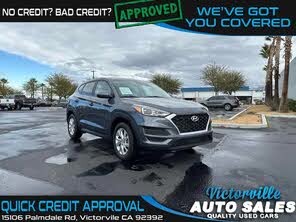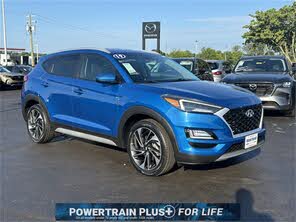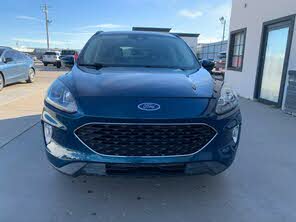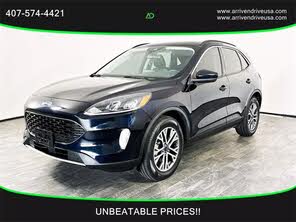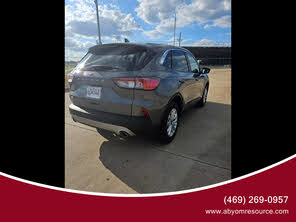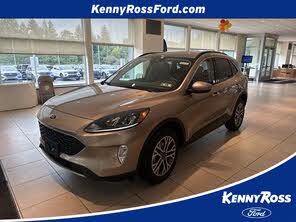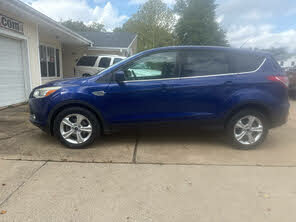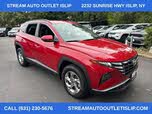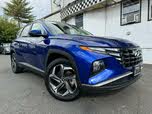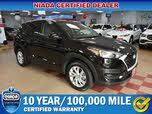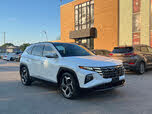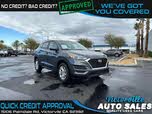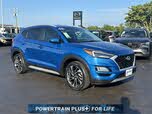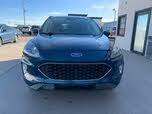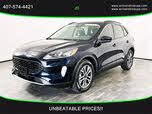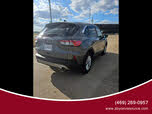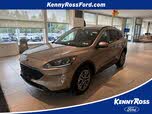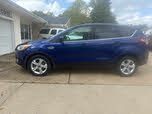Hyundai Tucson vs Ford Escape
Overview | |
Years produced2005-Present | Years produced2001-Present |
MSRP$27,500 | MSRP$28,000 |
Average price$19,699 | Average price$16,128 |
Listings8780 | Listings9006 |
Ratings & Reviews | |
User Reviews | User Reviews |
Expert reviews8.5 out of 10 | Expert reviews6.2 out of 10 |
Pros
| Pros
|
Reviews SummaryWith the growth and evolution of the compact SUV market, shoppers have seemingly endless options. And the growth of this segment has allowed for different models to grow in their own unique ways. The Mazda CX-5 is upscale and athletic, while the Ford Bronco Sport is a surprisingly capable off-roader. So what if you aren’t seeking a well-honed niche vehicle? What if you are looking for a small SUV that’s and overall great vehicle? The 2024 Hyundai Tucson answers that question as a well-rounded compact SUV that doesn’t excel in any one particular area, but instead covers a lot of what modern consumers demand out of their vehicle. This format is one that has been embraced by perennial segment standouts like the Toyota RAV4 and Honda CR-V. Verdict: The Tucson is a well-rounded small SUV and a good value. It does not shine in any particular area, instead blending good performance with a comfortable and spacious cabin, impressive tech and safety features, and an attractive price tag. | |
Reviews SummaryReportedly, Ford will discontinue the Escape at the end of the current fourth-generation run. Once among the most popular vehicles in its class, Ford recently zigged with the Escape’s design and positioning when the market zagged. Boxy, rugged-looking crossovers are what people want, not soft and sophisticated pseudo-cars like the current Escape. Fortunately, Ford has the Bronco Sport in its lineup, which is getting all of the automaker’s attention. Meanwhile, the 2024 Ford Escape receives no major changes following a substantial makeover in 2023, though it appears the Base trim is canceled. | |
No video found | |
Popular Features & Specs | |
Engine2.5L 187 hp I4 | Engine1.5L 180 hp I3 |
Drive TrainFWD | Drive TrainFWD |
Seating Capacity5 | Seating Capacity5 |
Horsepower187 hp @ 6100 rpm | Horsepower180 hp @ 6000 rpm |
MPG City25 | MPG City27 |
MPG Highway32 | MPG Highway34 |
Engine | |
Engine Name2.5L 187 hp I4 | Engine Name1.5L 180 hp I3 |
Torque178 lb-ft @ 4000 rpm | Torque199 lb-ft @ 3000 rpm |
Horsepower187 hp @ 6100 rpm | Horsepower180 hp @ 6000 rpm |
DrivetrainFWD | DrivetrainFWD |
Fuel Economy | |
MPG City25 | MPG City27 |
MPG Highway32 | MPG Highway34 |
Interior | |
Seating Capacity5 | Seating Capacity5 |
Safety | |
Front Crash Overall5 | Front Crash Overall5 |
Side Crash Overall5 | Side Crash Overall5 |
Dimensions & Capacity | |
Cargo Space38.7 cu ft | Cargo Space37.5 cu ft |
Curb Weight3346 lbs | Curb Weight3291 lbs |
Height65.6 in | Height66.0 in |
Length182.3 in | Length180.1 in |
Width73.4 in | Width85.6 in |
Wheelbase108.5 in | Wheelbase106.7 in |
Maximum Payload1283 lbs | Maximum Payload |
Number of doors4 | Number of doors4 |
Maximum Towing Capacity2000 lbs | Maximum Towing Capacity2000 lbs |
Standard Towing Capacity2000 lbs | Standard Towing Capacity |
Overview | ||
Years produced | 2005-Present | 2001-Present |
MSRP | $27,500 | $28,000 |
Average price | $19,699 | $16,128 |
Listings | ||
Ratings & Reviews | ||
User reviews | ||
Expert reviews | 8.5 out of 10Read full review | 6.2 out of 10Read full review |
Pros & cons | Pros
| Pros
|
Summary | With the growth and evolution of the compact SUV market, shoppers have seemingly endless options. And the growth of this segment has allowed for different models to grow in their own unique ways. The Mazda CX-5 is upscale and athletic, while the Ford Bronco Sport is a surprisingly capable off-roader. So what if you aren’t seeking a well-honed niche vehicle? What if you are looking for a small SUV that’s and overall great vehicle? The 2024 Hyundai Tucson answers that question as a well-rounded compact SUV that doesn’t excel in any one particular area, but instead covers a lot of what modern consumers demand out of their vehicle. This format is one that has been embraced by perennial segment standouts like the Toyota RAV4 and Honda CR-V. Verdict: The Tucson is a well-rounded small SUV and a good value. It does not shine in any particular area, instead blending good performance with a comfortable and spacious cabin, impressive tech and safety features, and an attractive price tag. | Reportedly, Ford will discontinue the Escape at the end of the current fourth-generation run. Once among the most popular vehicles in its class, Ford recently zigged with the Escape’s design and positioning when the market zagged. Boxy, rugged-looking crossovers are what people want, not soft and sophisticated pseudo-cars like the current Escape. Fortunately, Ford has the Bronco Sport in its lineup, which is getting all of the automaker’s attention. Meanwhile, the 2024 Ford Escape receives no major changes following a substantial makeover in 2023, though it appears the Base trim is canceled. |
Video | No video found | |
Popular Features & Specs | ||
Engine | 2.5L 187 hp I4 | 1.5L 180 hp I3 |
Drive Train | FWD | FWD |
Seating Capacity | 5 | 5 |
Horsepower | 187 hp @ 6100 rpm | 180 hp @ 6000 rpm |
MPG City | 25 | 27 |
MPG Highway | 32 | 34 |
Engine | ||
Engine Name | 2.5L 187 hp I4 | 1.5L 180 hp I3 |
Torque | 178 lb-ft @ 4000 rpm | 199 lb-ft @ 3000 rpm |
Horsepower | 187 hp @ 6100 rpm | 180 hp @ 6000 rpm |
Drivetrain | FWD | FWD |
Fuel Economy | ||
MPG City | 25 | 27 |
MPG Highway | 32 | 34 |
Interior | ||
Seating Capacity | 5 | 5 |
Safety | ||
Front Crash Overall | 5 | 5 |
Side Crash Overall | 5 | 5 |
Dimensions & Capacity | ||
Cargo Space | 38.7 cu ft | 37.5 cu ft |
Curb Weight | 3346 lbs | 3291 lbs |
Height | 65.6 in | 66.0 in |
Length | 182.3 in | 180.1 in |
Width | 73.4 in | 85.6 in |
Wheelbase | 108.5 in | 106.7 in |
Maximum Payload | 1283 lbs | |
Number of doors | 4 | 4 |
Maximum Towing Capacity | 2000 lbs | 2000 lbs |
Standard Towing Capacity | 2000 lbs | |
The 2024 Hyundai Tucson stepped into the spotlight with its fourth-generation model in 2022, and it carried forward much of its previous year's design into 2024. The Tucson's styling was nothing short of spectacular. It featured taut angles and unique design choices, like headlights that seamlessly blended into the grille. These aggressive details merged into a cohesive and handsome package that screamed modernity. Even in the typically photography-unfriendly white color, the Tucson managed to turn heads with its sharp looks. This athletic presence was accentuated by its contrasting angles and headlight integration, which was a nod to Hyundai’s contemporary design success. Unlike some luxury brands that make their entire vehicle lineup look uniformly similar, each Hyundai had its unique style.
The Tucson was available in SE, SEL, XRT, and Limited trim levels. The SE trim boasted 17-inch alloy wheels and roof rails, while the SEL's convenience package offered 19-inch alloy wheels. The XRT trim featured unique black 19-inch alloy wheels, side steps, dark exterior trim, and functional roof racks. The range-topping Limited trim had a dark chrome grille and upgraded headlights.
Inside, the Tucson continued its terrific design execution with a modern and refined cabin. Technology was abundant but packaged in an approachable way. However, the test model we drove lacked a volume dial, instead featuring touch-capacitive buttons and a toggle on the steering wheel. On a positive note, the placement of some controls near the shifter and cupholders was well-thought-out, even though it required some getting used to.
Standard features on the base SE trim included two USB ports, remote keyless entry, a manually adjustable driver’s seat, HD radio, power windows, and an 8-inch touchscreen infotainment system with wireless Apple CarPlay and Android Auto. As you moved up to the SEL, features like push-button start, a power-adjustable driver’s seat, dual-zone automatic climate control, wireless device charging, and more USB ports were added. The SEL Convenience package even offered synthetic leather upholstery and a leather-wrapped steering wheel. The XRT trim added SEL Convenience Package features as standard equipment. The top-tier Limited trim was incredibly well-equipped with ventilated front seats, heated rear seats, a heated steering wheel, genuine leather upholstery, a panoramic sunroof, an upgraded Bose premium stereo system, and memory settings for the driver’s seat.
In contrast, the 2024 Ford Escape received a significant refresh in 2023, with a revamped front end, new wheel designs, updated trim lineup, and next-gen infotainment and safety features, and carried these over into 2024. The new front end replaced the bland, wide-eyed look with a more aggressive appearance. However, much of the SUV's overall body remained soft and generically appealing.
Ford offered the 2024 Escape in various trims including the Active, ST-Line, ST-Line Select, ST-Line Elite, Platinum, and a Plug-in Hybrid. Notably, Ford dropped the Base trim, leading to prices ranging from $29,345 to $40,500, excluding the $1,495 destination fee.
Our test vehicle came in the ST-Line Elite trim with Rapid Red paint, black 19-inch wheels, the Premium Technology Package, and a Panoramic Vista Roof, bringing the total price to $43,650. The interior featured diamond-stitched, perforated leather seats and all tech upgrades we could think of, initially giving it an upscale appearance. However, the excessively glossy surfaces and unusually stiff leather upholstery fell short of expectations. Ford's attention to these details could vastly improve the interior experience, but with the Escape's rumored discontinuation, significant changes seemed unlikely.
The 2024 Hyundai Tucson featured a 2.5-liter four-cylinder engine that developed 187 horsepower and 178 pound-feet of torque, mated to an eight-speed automatic transmission. Front-wheel drive was standard, with all-wheel drive available as an option. This powertrain was the only non-hybrid option available, which was a bit of a letdown for those seeking variety. The engine was adequate for city driving, but getting up to highway speeds and making passing maneuvers required flooring the throttle, resulting in significant engine noise.
For drivers wanting more oomph, the Tucson had hybrid variations: a 226-horsepower Tucson Hybrid and a 261-horsepower Tucson Plug-In Hybrid. However, these versions came with a unique button-style shifter, found only on the Limited trim for the non-hybrid Tucson, which took some getting used to.
Where the Tucson truly shined was in its handling and ride quality. It struck a fine balance between ride comfort and cornering prowess. The ride was smooth enough to absorb road bumps comfortably, making it ideal for both long trips and daily commutes. While it wasn’t as athletic as rivals like the Mazda CX-5 or CX-50, the Tucson delivered a well-rounded driving experience with well-weighted and precise steering.
On the flip side, the 2024 Ford Escape ST-Line Elite offered two powertrain options: a 192-horsepower hybrid expected to get 39 mpg in combined driving, and a turbocharged 2.0-liter four-cylinder engine that produced 250 horsepower and 280 pound-feet of torque, averaging 26 mpg in combined driving. Our test vehicle had the turbo engine paired with an eight-speed automatic transmission and standard all-wheel drive.
The AWD system featured a driveline disconnect to improve fuel economy, and drivers could choose between Eco, Normal, Sport, and Slippery driving modes. Unlike the Tucson, there wasn’t an Off-Road mode available for the Escape. With the turbocharged engine, the Escape could tow up to 3,500 pounds.
Though marketed as the sporty version, the ST-Line Elite’s driving dynamics didn’t live up to the expectation set by its appearance. The turbo engine provided quick acceleration, but the ride was surprisingly soft and compliant. The handling felt nimble in typical driving situations, but the suspension allowed too much unwanted body motion. The brake pedal was responsive, but the steering lacked feedback and felt numb.
For most everyday scenarios, the Escape ST-Line provided a sporty look combined with comfortable and isolated driving dynamics, making daily commutes and errands more bearable. However, the turbocharged engine felt wasted in this setup, prompting us to recommend either opting for the hybrid powertrain or choosing a lower-trim model with the 1.5-liter turbocharged three-cylinder engine.
The 2024 Hyundai Tucson offered a generous cargo space, providing up to 74.8 cubic feet with the rear seats folded and up to 38.7 cubic feet with the rear seats in use. These impressive numbers made it one of the best among compact SUVs, second only to the Honda CR-V with 76.5 cubic feet. The Tucson SE came with a manual liftgate, while all other trims (SEL and above) featured a hands-free power liftgate. The intuitive hands-free system required only a fob to be within three feet of the rear bumper to open, making it highly convenient.
The Tucson’s interior was spacious enough for five passengers. Both rows provided ample headroom and legroom, with the front seats offering a bit more space. Accommodating four adults on long trips was a breeze, and plenty of deep cup holders and useful storage spaces throughout the cabin added to its practicality. A notable feature was the center tray between the shifter and the center stack, which housed the standard wireless device charging pad.
In comparison, the 2024 Ford Escape ST-Line had a somewhat restrictive interior color palette, offering only black upholstery with optional leather in the ST-Line Elite trim. The latter featured diamond-stitched leather, ambient interior lighting, dual-zone automatic climate control, a 10-way power-adjustable driver’s seat, heated front seats, and a heated steering wheel. While the leather seats looked fancy, they were uncomfortable. Ventilated front seats were noticeably absent.
The Escape’s front seats, while large and soft, provided good support over time. The rear seats offered comfort when reclined fully, making the Escape suitable for four adults on long journeys. Interior storage was generous upfront, but rear passengers had fewer conveniences. Cargo volume in the Escape measured 37.5 cubic feet behind the back seat or 34.4 cubic feet for the hybrid, expanding to 65.4 cubic feet when folded down (60.8 cubic feet for the hybrid). Deep storage areas on either side of the cargo floor and a handy grocery bag hook added to its functionality.
When comparing the two, the Tucson edged ahead in cargo capacity and offered more intuitive, user-friendly features that enhanced practical use.
The 2024 Hyundai Tucson came with a standard 8-inch touchscreen infotainment system, one of the best in the market, featuring wireless Apple CarPlay and Android Auto. The interface included side home buttons for easy operation and thumb rollers for volume and tuning. Higher trims like the SEL Convenience Package, XRT, and Limited included a fully digital instrument panel and a larger 10.25-inch touchscreen. However, these trims lost the wireless smartphone connectivity and replaced thumb rollers with a less convenient haptic volume toggle. Nonetheless, the touchscreen and buttons were glove-friendly, which was handy in cold weather.
Hyundai’s evolved remote start system was another thoughtful addition. It allowed the vehicle to recognize the key fob once inside, negating the need to press the start button and directly putting the car into Drive.
Meanwhile, the 2024 Ford Escape standard digital instrumentation came in an 8-inch display for lower trims and a 12.3-inch display for upper trims, adding to the ST-Line Elite’s tech-savvy aura. Its 13.2-inch Sync 4 infotainment system, presented in a landscape format, offered an intuitive layout but suffered from a color theme that appeared washed out and thin fonts that were hard to read at a glance. The integration of climate controls into a narrow strip of the display wasn’t ideal either.
Lower trims of the Escape had an 8-inch display with wireless Apple CarPlay and Android Auto, and SiriusXM 360L satellite radio. The larger touchscreen included Amazon Alexa and a three-year subscription to connected navigation. Unfortunately, the Bang & Olufsen premium sound system in our test vehicle had damaged speakers, preventing us from gauging sound quality. The Sync 4 system also exhibited a lag between inputs and responses, and the wireless smartphone charger heated devices to an alarming temperature. The voice recognition system, however, was excellent, and switching between Apple CarPlay and the native interface was seamless.
Ford’s odd placement of the engine start/stop button where a stereo volume knob usually is, and the absence of a tuning knob, were confusing design choices. The optional head-up display (HUD) was implemented via a pop-up plastic screen rather than projecting onto the windshield, which we found less effective. Active Park Assist 2.0 was included in the Premium Technology Package along with the HUD, leather, premium sound system, and more, but it proved impractical in busy environments.
Overall, Tucson’s user-friendly and intuitive tech features positioned it as the more technologically advanced vehicle.
The 2024 Hyundai Tucson came packed with a comprehensive suite of driver assistance features, including automatic emergency braking, forward collision warning, pedestrian and cyclist detection, adaptive cruise control, lane-departure warning, lane-keeping assist, automatic high beams, driver attention monitoring, blind-spot monitoring, and rear cross-traffic alert. The Limited trim added even more safety features like front and rear parking sensors, a 360-degree parking camera system, and Hyundai’s Smart Park remote-parking feature.
The Tucson also earned high marks from safety organizations. The Insurance Institute for Highway Safety (IIHS) rated it “Good” in most crash tests, an “Acceptable” score for standard headlights, and a “Superior” rating for crash-prevention technology. The IIHS named it a Top Safety Pick+ for 2023, and the 2024 model is largely the same. The National Highway Traffic Safety Administration (NHTSA) awarded it five stars in a frontal crash test and four stars in a rollover test.
The 2024 Ford Escape also prioritized safety, featuring a standard post-collision automatic braking system and the Ford Co-Pilot360 suite, which included forward-collision warning, pedestrian detection, automatic emergency braking, lane-departure warning, lane-keeping assist, blind-spot monitoring, rear cross-traffic alert, and automatic high-beams. The ST-Line Elite additionally offered adaptive cruise control with stop-and-go, evasive steering assist, lane-centering assist, and a 360-degree camera system.
However, while testing Co-Pilot360, inconsistencies arose, particularly with the lane-keeping and predictive speed assist features, which detracted from the overall driving experience. These systems performed better on freeways, but they still fell short compared to the seamless operation of Hyundai’s safety tech.
In crash tests, the NHTSA gave the Escape five-star ratings across the board, except for a four-star rollover rating. The IIHS had not yet rated the 2024 model, but the 2023 model earned Good ratings, with a Marginal score in a new side-impact test.
CarGurus highlights

According to CarGurus experts, the overall rating for the 2024 Hyundai Tucson is 8.5 out of 10, while the 2024 Ford Escape scores 6.2 out of 10. With higher safety scores, better cargo capacity, user-friendly technology, and a well-rounded driving experience, the 2024 Hyundai Tucson stands out as the superior choice for consumers looking for a balanced, reliable, and feature-rich compact SUV. The Tucson’s combination of style, practicality, and advanced features makes it the recommended vehicle in this comparison.
Choose the 2024 Hyundai Tucson if:
- You prioritize advanced safety features and high crash-test ratings.
- You need ample cargo space and user-friendly, intuitive tech.
- You prefer a refined and distinct design with superior ride quality.
Choose the 2024 Ford Escape if:
- You want a sportier-looking vehicle with a powerful turbocharged engine option.
- You prefer extensive trim levels and customization opportunities.
- You appreciate semi-autonomous parking assistance technology.
CarGurus highlights

According to CarGurus experts, the overall rating for the 2024 Hyundai Tucson is 8.5 out of 10, while the 2024 Ford Escape scores 6.2 out of 10. With higher safety scores, better cargo capacity, user-friendly technology, and a well-rounded driving experience, the 2024 Hyundai Tucson stands out as the superior choice for consumers looking for a balanced, reliable, and feature-rich compact SUV. The Tucson’s combination of style, practicality, and advanced features makes it the recommended vehicle in this comparison.
Choose the 2024 Hyundai Tucson if:
Shop Now- You prioritize advanced safety features and high crash-test ratings.
- You need ample cargo space and user-friendly, intuitive tech.
- You prefer a refined and distinct design with superior ride quality.
Choose the 2024 Ford Escape if:
Shop Now- You want a sportier-looking vehicle with a powerful turbocharged engine option.
- You prefer extensive trim levels and customization opportunities.
- You appreciate semi-autonomous parking assistance technology.

By: CarGurus + AI
At CarGurus, our team of experienced automotive writers remain at the heart of our content operation, conducting hands-on car tests and writing insightful guides that are backed by years of industry experience. To complement this, we are harnessing AI to make our content offering more diverse and more helpful to shoppers than ever. To achieve this, our AI systems are based exclusively on CarGurus content, ratings and data, so that what we produce is both unique to CarGurus, and uniquely helpful to car shoppers.
